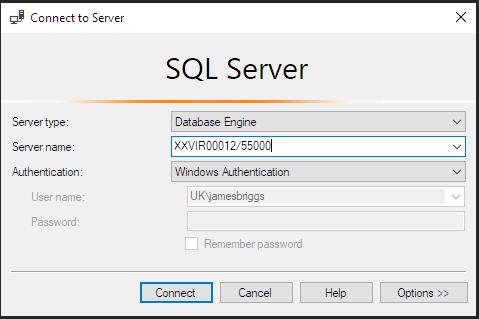这篇文章给大家介绍Python中怎么实现SQL自动化,内容非常详细,感兴趣的小伙伴们可以参考借鉴,希望对大家能有所帮助。
从基础开始
import pyodbc from datetime import datetime classSql: def__init__(self, database, server="XXVIR00012,55000"): # here we are telling python what to connect to (our SQL Server) self.cnxn = pyodbc.connect("Driver={SQL Server Native Client 11.0};" "Server="+server+";" "Database="+database+";" "Trusted_Connection=yes;") # initialise query attribute self.query ="-- {}\n\n-- Made in Python".format(datetime.now() .strftime("%d/%m/%Y"))这个代码就是操作MS SQL服务器的基础。只要编写好这个代码,通过Python 连接到SQL 仅需:
sql = Sql('database123')很简单对么?同时发生了几件事,下面将对此代码进行剖析。class Sql:
首先要注意,这个代码包含在一个类中。笔者发现这是合乎逻辑的,因为在此格式中,已经对此特定数据库进行了增添或移除进程。若见其工作过程,思路便能更加清晰。
初始化类:
def __init__(self, database,server="XXVIR00012,55000"):
因为笔者和同事几乎总是连接到相同的服务器,所以笔者将这个通用浏览器的名称设为默认参数server。
在“Connect to Server”对话框或者MS SQL Server Management Studio的视窗顶端可以找到服务器的名称:

下一步,连接SQL:
self.cnxn =pyodbc.connect("Driver={SQL Server Native Client 11.0};" "Server="+self.server+";" "Database="+self.database+";" "Trusted_Connection=yes;")pyodbc 模块,使得这一步骤异常简单。只需将连接字符串过渡到 pyodbc.connect(...) 函数即可,点击以了解详情here。
最后,笔者通常会在 Sql 类中编写一个查询字符串,sql类会随每个传递给类的查询而更新:
self.query = "-- {}\n\n--Made in Python".format(datetime.now() .strftime("%d/%m/%Y"))这样便于记录代码,同时也使输出更为可读,让他人读起来更舒服。
请注意在下列的代码片段中,笔者将不再更新代码中的self.query 部分。
组块
一些重要函数非常有用,笔者几乎每天都会使用。这些函数都侧重于将数据从数据库中传入或传出。
以下图文件目录为始:

对于当前此项目,需要:
将文件导入SQL
将其合并到单一表格内
根据列中类别灵活创建多个表格
SQL类不断被充实后,后续会容易很多:
import sys sys.path.insert(0, r'C:\\User\medium\pysqlplus\lib') import os from data importSql sql =Sql('database123') # initialise the Sql object directory =r'C:\\User\medium\data\\' # this is where our generic data is stored file_list = os.listdir(directory) # get a list of all files for file in file_list: # loop to import files to sql df = pd.read_csv(directory+file) # read file to dataframe sql.push_dataframe(df, file[:-4]) # now we convert our file_list names into the table names we have imported to SQL table_names = [x[:-4] for x in file_list] sql.union(table_names, 'generic_jan') # union our files into one new table called 'generic_jan' sql.drop(table_names) # drop our original tables as we now have full table # get list of categories in colX, eg ['hr', 'finance', 'tech', 'c_suite'] sets =list(sql.manual("SELECT colX AS 'category' FROM generic_jan GROUP BY colX", response=True)['category']) for category in sets: sql.manual("SELECT * INTO generic_jan_"+category+" FROM generic_jan WHERE colX = '"+category+"'")从头开始。
入栈数据结构
defpush_dataframe(self, data, table="raw_data", batchsize=500): # create execution cursor cursor = self.cnxn.cursor() # activate fast execute cursor.fast_executemany =True # create create table statement query ="CREATE TABLE ["+ table +"] (\n" # iterate through each column to be included in create table statement for i inrange(len(list(data))): query +="\t[{}] varchar(255)".format(list(data)[i]) # add column (everything is varchar for now) # append correct connection/end statement code if i !=len(list(data))-1: query +=",\n" else: query +="\n);" cursor.execute(query) # execute the create table statement self.cnxn.commit() # commit changes # append query to our SQL code logger self.query += ("\n\n-- create table\n"+ query) # insert the data in batches query = ("INSERT INTO [{}] ({})\n".format(table, '['+'], [' # get columns .join(list(data)) +']') + "VALUES\n(?{})".format(", ?"*(len(list(data))-1))) # insert data into target table in batches of 'batchsize' for i inrange(0, len(data), batchsize): if i+batchsize >len(data): batch = data[i: len(data)].values.tolist() else: batch = data[i: i+batchsize].values.tolist() # execute batch insert cursor.executemany(query, batch) # commit insert to SQL Server self.cnxn.commit()此函数包含在SQL类中,能轻松将Pandas dataframe插入SQL数据库。
其在需要上传大量文件时非常有用。然而,Python能将数据插入到SQL的真正原因在于其灵活性。
要横跨一打Excel工作簿才能在SQL中插入特定标签真的很糟心。但有Python在,小菜一碟。如今已经构建起了一个可以使用Python读取标签的函数,还能将标签插入到SQL中。
Manual(函数)
defmanual(self, query, response=False): cursor = self.cnxn.cursor() # create execution cursor if response: returnread_sql(query, self.cnxn) # get sql query output to dataframe try: cursor.execute(query) # execute except pyodbc.ProgrammingErroras error: print("Warning:\n{}".format(error)) # print error as a warning self.cnxn.commit() # commit query to SQL Server return"Query complete."此函数实际上应用在union 和 drop 函数中。仅能使处理SQL代码变得尽可能简单。
response参数能将查询输出解压到DataFrame。generic_jan 表中的colX ,可供摘录所有独特值,操作如下:
sets =list(sql.manual("SELECT colX AS 'category' FROM generic_jan GROUP BYcolX", response=True)['category'])Union(函数)
构建 了manual 函数,创建 union 函数就简单了:
defunion(self, table_list, name="union", join="UNION"): # initialise the query query ="SELECT * INTO ["+name+"] FROM (\n" # build the SQL query query +=f'\n{join}\n'.join( [f'SELECT [{x}].* FROM [{x}]'for x in table_list] ) query +=") x" # add end of query self.manual(query, fast=True) # fast execute创建 union 函数只不过是在循环参考 table_list提出的表名,从而为给定的表名构建 UNION函数查询。然后用self.manual(query)处理。
Drop(函数)
上传大量表到SQL服务器是可行的。虽然可行,但会使数据库迅速过载。 为解决这一问题,需要创建一个drop函数:
defdrop(self, tables): # check if single or list ifisinstance(tables, str): # if single string, convert to single item in list for for-loop tables = [tables] for table in tables: # check for pre-existing table and delete if present query = ("IF OBJECT_ID ('["+table+"]', 'U') IS NOT NULL " "DROP TABLE ["+table+"]") self.manual(query) # execute关于Python中怎么实现SQL自动化就分享到这里了,希望以上内容可以对大家有一定的帮助,可以学到更多知识。如果觉得文章不错,可以把它分享出去让更多的人看到。
免责声明:本站发布的内容(图片、视频和文字)以原创、转载和分享为主,文章观点不代表本网站立场,如果涉及侵权请联系站长邮箱:is@yisu.com进行举报,并提供相关证据,一经查实,将立刻删除涉嫌侵权内容。